Régiment d'Auxonne
The Régiment d'Auxonne was an artillery regiment of the Ancien Régime Army, formed during the Seven Years' War the regiment saw service in many of the major campaigns until being, re-organised in 1794, and later served in the Grande Armée. The regiment's successor, the 6th Artillery Regiment would continue to serve until 1993 when it was disbanded after the end of the Cold War.
| 6éme Bataillon de Royal Artillerie Régiment d'Auxonne 6éme Régiment d'Artillerie | |
|---|---|
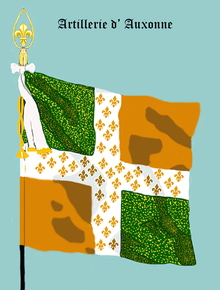 Regimental Colours, granted in 1765 | |
| Active | 1757–1794 |
| Country | |
| Allegiance | King of France French Nation |
| Branch | |
| Type | Field Artillery |
| Size | Formed as 1 Battalion, largest at 3 Battalions during Napoleonic Wars |
| Headquarters | Auxonne |
| Equipment | Gribeauval System |
| Engagements | Seven Years' War American Revolutionary War |
Seven Years' War
Invasion of Hanover

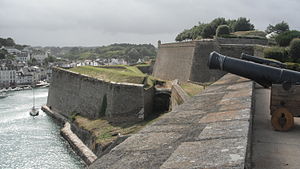
The 6éme Bataillon de Royal-Artillerie was formed by ordinance on 1 January 1757 by the Marquis de Cosne by means of a detachment of 120 men from each of the other five battalions of artillery. As soon as the regiment was organised, it was sent into Germany to join the Army of the Lower Rhine commanded by Louis Charles César Le Tellier, Comte d'Estrées for the upcoming Invasion of Hanover. Shortly after the army launched into Hanover, and swiftly captured almost all of the major cities, causing the Hanoverians to sign the Convention of Klosterzeven, where Hanover agreed to pull out of the war. After the convention, the battalion moved with the army, new lead by Louis François Armand du Plessis, Duc de Richelieu, who encampted in Halberstadt in Prussian territorial from 28 September to 5 November. At the end of the year, the battalion took winter-quarters in the first line in Braunschweig (Brunswick).[1]
Rhine Campaign
In April 1758, when Louis de Bourbon-Condé, Comte de Clermont-en-Argonne re-deployed his army along the Rhine, with the battalion being stationed with the La Motte and Menouville battalions, garrisoned in the fortified brigadehead in Büderich opposite Wesel. After the successful crossing of the Rhine by the army of Duke Ferdinand of Brunswick-Wolfenbüttel on 31 May, the battalion was relieved towards Rheinberg where it join Clermont's army on June 2nd. The battalion then formed part of the reserve until June 12. On 23 June, the battalion took part in the Battle of Krefeld, serving under the Marquis de la Vallière. In mid-August, after Ferdinand's retreat to the east bank of the Rhine, the battalion accompanied the Army of the Lower Rhine now lead by Louis Georges Érasme, Marquis de Contades when it recrossed the Rhine for an offensive in Westphalia, and on 20 August the battalion was encamped near Wesel.[1]
Western German Campaign
From June 1759, the battalion took part in the French offensive in Western Germany, and on 1 August it fought in the Battle of Minden, and by 30 December it took winter-quarters in Offenbach. By the end of January 1760, the battalion took winter quarters in the third-line of the French Army along the Rhine and the Main at its mouth. By mid-March, the regiment was billeted in Offenbach, still in the third line. By 23 May, the battalion joined Victor François, Duc de Broglie's army, and later took part in the Siege of Cassel and also participated in the Battle of Corbach, and later Battle of Warburg.[1]
In 1761, the battalion took part in the defence of Kassel and later the Battle of Villinghausen. A detachment of the battalion distinguished itself during the Capture of Belle Île, even though it had to surrender in the end. On 21 September 1762, the battalion took part in the Battle of Amoneburg.[1]
Peacetime
When peace was declared after the end of the Seven Years' War, the regiment retired from Germany, and moved to Auxonne. On 13 August 1765, when the regiment was in the town of the same name, it was re-named as the Régiment d'Auxonne, and subsequently granted their Drapeau d'Ordonnance shortly after. Originally, the regimental colours were the same as the Régiment de Metz, but in reverse order. Following the end of the Seven Years' War, the Bord de Les Munitions (Board of Ordnannce) addressed a serious problem within the artillery, which was the use of artillery and the system by which it was equipped and performed. The first senior officer to notice this problem was, the later well known, Jean-Baptiste Vaquette de Gribeauval who had studied Prussian artillery just before the last war, and now was ready to implement his new system of artillery.[1][2][3][4]
In October 1766 the regiment moved to Metz, in October 1769 to Douai, January 1771 to Brest, in July 1771 to Besançon, and in October 1775 to La Fère where it adopted the Gribeauval system of guns. Just before moving to America, the regiment was organised into twenty companies, with ten in each of the two battalions.[1][3][5]
American Revolutionary War
American Service
When the war in America started, the regiment was stationed in Brittany. In 1779, the regiment was split, the 1st battalion joining the Observation Corps under Noël Jourda, Comte de Vaux, which was intended to land in England and end the war in a quick strike. Due to poor communication and bad weather, the invasion never happened, and the battalion returned to garrison duties. Meanwhile, the 2nd battalion was distributed around the coast near Brest and shortly thereafter joined the Expédition Particulière, lead by Général Jean-Baptiste Donatien de Vimeur, Comte de Rochambeau.[1][3][5]
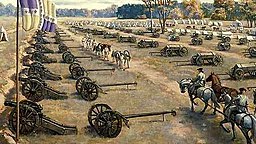
Immediately upon arrival the regiment took up quarters in Newport and remained there through the winter, it was only in June 1781 that the army was concentrated and united with the American Army. Later, the armies made their way to the town of Yorktown as Nathanael Greene's Southern Campaign came to an end. When the regiment arrived in Yorktown it was assigned to the artillery group commanded by Lieutenant Colonel François Marie, Comte d'Aboville, and positioned in the centre of the line next to the american artillery with the Bourbonnais and Royal Deux-Ponts to their left and the New York and Virginia Lines to their right.[1][3][5]
After the end of the siege, the regiment remained in Virginia for a short time before moving back to Rhode Island and embarking for France.[1]
Régiment Provinical d'Artillerie d'Auxonne
Just as the Anglo-French War started in 1778, the Régiment Provincial d'Artillerie d'Auxonne (Provincial Artillery Regiment of Auxonne) was formed through the amalgamation of the Châlons and Autun artillery battalions. The regiment's commanding officers were the Comte d'Ailly in 1778, and the Comte d'Erhard in 1788.[1][2][4]
During this period, the regiment was more of a cadre sized regiment, rather then a fully equipped unit, therefore it was controlled by the Régiment des Grenadiers Royaux du Comté de Bourgogne, along with the provincial artillery of Besançon and de Toul. By order of the King concerning the royal grenadiers, on 8 April 1779, the Grenadiers Royaux du Lyonnois was attached to the regiment for administrative purposes along with a company of the Régiment Provincial de Dijon. The regiment was disbanded in 1789 following the French Revolution.[1][2][4][6]
French Revolution
In 1781 the regiment arrived back in France in Le Havre where it remained, and towards the end of 1782 it moved to Geneva, and eventually moved to Auxonne. The 2nd battalion then joined the 1st in Auxonne and in September 1786 it moved to Metz where it held the garrison during the first stages of the revolution.[1]
In April 1792, three and a-half companies left Metz to join the Army of the Ardennes, while the other companies joined the Army of the Centre, and later saw action during the Battle of Valmy. During the next few years of the War of the First Coalition, the regiment and its sub-components served in the Army of the Sambre and Meuse and Army of the Rhine and Moselle before being re-organised into the 6éme Régiment d'Artillery à Pied in 1794.[1]
Although the royalist connection was ended in 1794, the regiment's successor the 6éme Régiment d'Artillerie would see service in all the major campaigns of the Napoleonic Wars, including the Battle of Waterloo where the 1st, 7th, 9th, 10th, 11th, 18th, 19th, and 20th companies of the regiment saw action.[1][7][8]
Colours
The maintained two colours, first being the Colonel's Colours Deapeau Colonel and the Regimental Colours Drapeau d'Ordonnance.
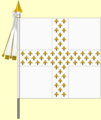 Colonel's Colours for Royal French Artillery.
Colonel's Colours for Royal French Artillery.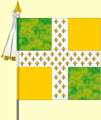 Regimental Colours of the regiment until 1791, when the artillery lost their colours.
Regimental Colours of the regiment until 1791, when the artillery lost their colours.
Commanding Officers
Commanding officers of the regiment before 1796 included:[1]
- 1757–1759 André-Claude de Cosne
- 1759–1761 Pierre-François Ansard de Mouy
- 1761—1761 Arnould de Loyauté
- 1761–1765 Louis-Henri Ballard d'Invilliers
- 1765–1769 Phillipe-Louis, Verton de Richeval
- 1769–1780 Jean-Marie-Antoine Verton de La Mortière
- 1780–1788 Amour-Constant de Cirfontaine, Chevalier de Germay
- 1788–1792 François-Charles, Quiefdeville de Belmesnil
- 1792—1793 Charles-François Daniel Dutot
- 1793—1794 Charles de Bonvoust
- 1794—1794 Jacques Bardenet
Footnotes
- Susane, Volume VI, pp. 249–251.
- Susane, Volume I, p. 300.
- Smith, American War of Independence, pp. 184–7.
- Susane, Volume VIII, p. 351.
- Combatants of France, pp. 314, XI.
- King's Ordnance of 8 April 1779, pp. 4, 8.
- "Les Uniformes pendant la campagne des Cent Jours - Belgique 1815". centjours.mont-saint-jean.com. Retrieved 2020-07-04.
- Smith, Napoleonic Wars, pp. 52, 74.
References
- Ordnance of the King, Concerning the Royal Grenadiers, 8 April 1779, Paris, France.
- Louis Susane, History of the Ancient French Infantry Volume I, 1849 Military Library, Maritime and Polytechnic, Paris, France.
- Louis Susane, History of the Ancient French Infantry Volume VI, 1852 Military Library, Maritime and Polytechnic, Paris, France.
- Ministry of Foreign Affairs, Les Combattants Français de la Guerre Américaine 1778–1783, 1903 Paris, France.
- Digby Smith, Kevin E. Kiley, and Jeremy Black, An Illustrated Encyclopedia of Uniforms of the American War of Independence, 2017 Lorenz Books, London, United Kingdom. ISBN 978-0-7548-1761-1.
- Digby Smith & Jeremy Black, An Illustrated Encyclopedia of Uniforms of the Napoleonic Wars, 2015 Lorenz Books, London, United Kingdom. ISBN 978-0-7548-1571-6.